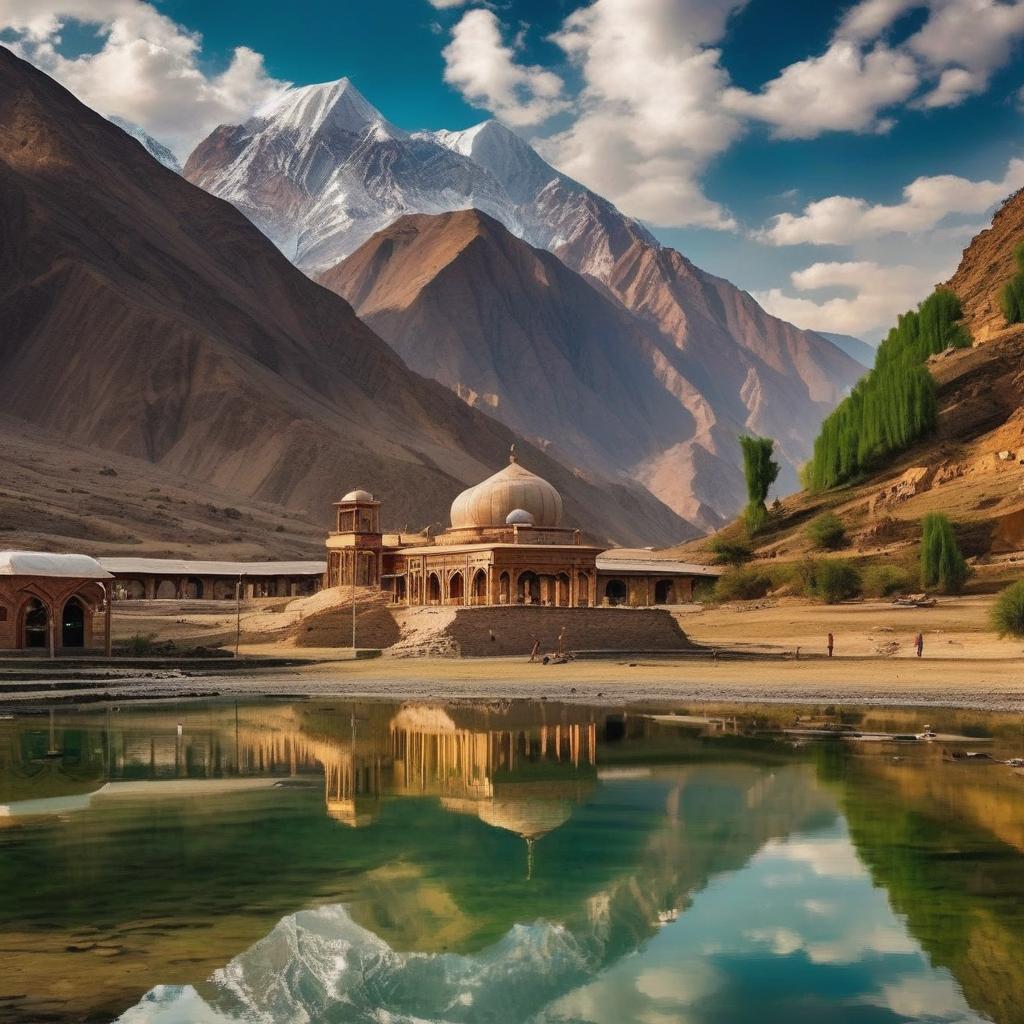Tourist Attractions in Pakistan
Nestled at the crossroads of South Asia, Pakistan, often referred to as the “Land of Pure,” is a hidden gem awaiting discovery by adventurous travelers. Its diverse landscape ranges from soaring mountain peaks to ancient ruins, offering a unique blend of natural beauty and cultural wealth. Despite its often overshadowed presence on the global travel stage, Pakistan’s breathtaking vistas, historic relics, and welcoming hospitality make it an unmissable destination for those seeking to explore beyond conventional tourist paths. This article delves into the myriad of experiences awaiting visitors, from the northern highlands’ majesty to the enduring legacies of ancient civilizations.
Northern Wonders:Mountains and Valleys
Hunza Valley: A Paradise on Earth
Situated in the Gilgit-Baltistan region, Hunza Valley captivates with its serene environment and awe-inspiring landscapes. Enclosed by the grandiose peaks of the Karakoram Range, including the formidable Rakaposhi, the valley is a haven for nature lovers and trekkers. Visitors can explore quaint villages where time seems to stand still, with terraced fields of apricot orchards painting a vivid portrait of the region. The area’s pedestrian-friendly layout encourages leisurely strolls, which often lead to breathtaking viewpoints and intimate encounters with local culture.
The famed Karakoram Highway, dubbed the eighth wonder of the world, provides an epic route for travelers eager to experience the thrill of high-altitude adventures. Hunza Valley is more than just its natural splendor; it’s an embodiment of the warmth and simplicity of its people, whose traditions and hospitality invite you to linger and explore further.
Skardu:The Gateway to the Mighty Karakorams
Renowned as the gateway to some of the world’s highest peaks, including K2—the second highest mountain on Earth—Skardu offers an unparalleled experience for mountaineers and nature enthusiasts. Beyond its towering summits, Skardu boasts serene alpine lakes such as the stunning Shangrila Resort, also known as “Heaven on Earth,” and the expansive Sheosar Lake, known for its glass-like reflection of surrounding landscapes.
The Deosai Plains, a high-altitude plateau often referred to as the “Land of Giants,” is a summer highlight, transforming into a golden sea of wildflowers that contrasts vividly with the rugged peaks. Wildlife enthusiasts will relish opportunities to spot Himalayan brown bears and other rare species throughout the region. Skardu also serves as a cultural touchpoint, with fortresses like Skardu Fort offering glimpses into its rich heritage and history.
Fairy Meadows: Views of the Killer Mountain
For those seeking an adrenaline rush coupled with sublime beauty, a trek to Fairy Meadows is an essential expedition. This lush green meadow offers unobstructed views of Nanga Parbat, famously known as the “Killer Mountain” due to its formidable climbing history. But beyond its challenging ascent, the mountain’s allure lies in the diverse biomes surrounding it, including the pine forests and clear, crisp air of Fairy Meadows, which provide a tranquil respite.
Camping here is a bucket-list experience, with the star-studded sky and the tranquil silence further enhancing the ethereal ambiance. Whether you’re a seasoned trekker or a traveler keen on a contemplative retreat, Fairy Meadows provides a rewarding contrast of challenge and peace.
Swat Valley:The Switzerland of the East
With its misty mountains and pristine rivers, Swat Valley has earned its reputation as the “Switzerland of the East.” Nestled within its breathtaking scenery are cascading waterfalls, rolling meadows, and the historical whispers of ancient Buddhist civilization, evidenced by the well-preserved stupas and monastery ruins scattered among the hills.
Beyond its natural allure, Swat Valley offers rich cultural encounters. The people of Swat, known for their resilience and warmth, welcome visitors, allowing for shared experiences over traditional teas and candid stories of the valley’s storied past. Springtime reveals the valley in its full glory, with an eruption of wildflowers and the invigorating fresh air of alpine forests making it an ideal destination for those seeking both beauty and serenity.
Historical Marvels
Lahore Fort: A Mughal Masterpiece
Lahore Fort, a UNESCO World Heritage site, is a splendid example of Mughal architecture, standing as a testament to the dynasty’s grandeur and architectural prowess. Located in the heart of Lahore, the fort is a superb blend of intricate frescoes, vast courtyards, and impressive gateways including the iconic Alamgiri Gate. Its storied past unfolds as you explore the complex, where every corner tells a tale of the empire’s history.
Visitors can explore the Sheesh Mahal, or Palace of Mirrors, renowned for its elaborate mirror work inlaid in walls and ceilings, casting mesmerizing reflections of light. The fort serves as a cultural anchor in Lahore, providing visitors a journey back in time through its stunning architecture and enduring legacy.
Badshahi Mosque:An Architectural Wonder
Situated opposite the Lahore Fort, the Badshahi Mosque is an awe-in spiring monument that captivates visitors with its grandeur and symmetry. Constructed in 1673 by the Mughal Emperor Aurangzeb, it stands as one of the largest mosques in the world and a crowning glory of Mughal architecture. Its striking red sandstone structure, adorned with intricate marble inlays and massive domes, reflects both the artistic and spiritual aspirations of its creators.
Visitors are drawn to the mosque’s expansive courtyard, which can accommodate tens of thousands of worshippers. The majestic entry gates and elaborately sculpted chambers offer insight into the architectural genius of the Mughal era. A visit to Badshahi Mosque is not just an exploration of architectural beauty but also an immersion into the spiritual heart of Lahore, where the past seamlessly blends with the present.
Ranikot Fort:The Great Wall of Sindh
Often referred to as the “Great Wall of Sindh,” Ranikot Fort is one of the world’s largest fort complexes, sprawling over 26 kilometers across the rolling Kirthar hills. This mysterious and imposing structure is shrouded in myths and legends, its origins and purposes still debated by historians. The fort’s sheer size and enigmatic history make it a fascinating destination for explorers and history buffs.
As you wander through Ranikot’s ruins, you can explore its massive bastions, ancient gates, and the surrounding vast desert landscape. A journey to this remote part of Sindh feels like stepping back in time, offering a unique experience of Pakistan’s lesser-known historical sites.
Mohenjo-Daro:An Ancient Indus Valley Civilization Site
Mohenjo-Daro stands as a testament to the advanced engineering and urban planning of the Indus Valley Civilization, one of the world’s oldest urban centers dating back over 4,500 years. This ancient site offers a poignant view into a civilization that was remarkably sophisticated, with developed city layouts that included a complex drainage system and architectural marvels like the Great Bath.
As you walk through the remnants of Mohenjo-Daro, you can witness the intricate planning of streets, residential blocks, and public spaces that reveal the everyday life, trade, and governance of the period. The on-site museum offers valuable artifacts, providing further insight into the rich cultural and technological achievements of this ancient society. Mohenjo-Daro is more than just a ruins site—it’s an echo of human ingenuity and cultural continuity across millennia.
Cultural Experiences
Kalash Valleys: A Unique Culturein Chitral
Nestled within the remote mountains of Chitral, the Kalash Valleys are home to the Kalasha people, known for their vibrant festivals, colorful traditional dress, and unique cultural identity. The valleys, including Bumburet, Rumbur, and Birir, serve as a living museum of ancient heritage and are renowned for their cultural festivals such as Chilam Joshi and Uchal, which celebrate seasonal changes with music, dance, and communal feasting.
Visitors to the Kalash Valleys are often captivated by the hospitality and spirited nature of the Kalasha people. Interactions reveal a society deeply connected to its traditions yet welcoming of curious travelers, offering a cultural experience that is both enriching and humbling.
Multan: The City of Saintsand Shrines
Multan is known as the City of Saints, thanks to its rich tapestry of Sufi shrines, each adorned with exquisite blue tilework that reflects the spiritual depth and artistic finesse of the region. The city exudes a mystical atmosphere, attracting pilgrims and spiritual seekers from around the world. Notable shrines include those of Bahauddin Zakariya and Shah Rukn-e-Alam, whose historical and spiritual significance permeate the cultural fabric of the city.
Visitors to Multan can explore its bustling bazaars filled with local crafts and textiles, where vibrant colors and intricate designs speak to the cultural diversity of the area. The city’s blend of spiritual heritage and lively commerce make it a fascinating destination for those interested in the complex cultural layers of Pakistan.
Peshawar: The HistoricFrontier City
As one of the oldest cities in South Asia, Peshawar has been a crossroads of civilizations for centuries, offering a rich tapestry of history and culture. Its historic bazaars, such as Qissa Khwani Bazaar, provide a glimpse into the past with their array of spices, textiles, and traditional wares. Peshawar’s ancient sites, including the Bala Hissar Fort and the iconic Mahabat Khan Mosque, reflect its strategic importance through the ages.
Visitors to Peshawar can experience the city’s unique blend of cultures and traditions, from its famous hospitality to the rich flavors of Pashtun cuisine. Navigating its bustling streets, encountering the friendly locals, and exploring its heritage sites offer an immersive experience of life on the historic frontier.
Natural Splendors
Deosai National Park:The Land of Giants
Deosai National Park, also known as the “Roof of the World,” is a high-altitude plateau that presents a vast expanse of untouched wilderness. Elevated at over 4,000 meters above sea level, Deosai spans lush meadows and rugged peaks, offering a sanctuary for wildlife such as the Himalayan brown bear, snow leopards, and a multitude of bird species. Known for its dramatic seasonal transformations, the plateau is covered in a blanket of wildflowers during summer, adding a kaleidoscope of colors to the landscape.
Travelers to Deosai can enjoy unparalleled opportunities for trekking, camping under starlit skies, and wildlife photography. The park’s sheer expanse and pristine environment make it an ideal destination for those seeking solitude and communion with nature’s grandeur.
Kund Malir Beach:A Serene Coastal Escape
Situated along the picturesque Makran Coastal Highway, Kund Malir Beach offers a tranquil retreat far removed from the hustle and bustle of urban life. The beach’s golden sands and azure waters are set against the backdrop of rugged cliffs and rolling hills, providing a stunning natural landscape perfect for relaxation.
Visitors can take leisurely walks along the shoreline, discover marine life in the tide pools, or simply soak up the sun in peaceful solitude. Kund Malir is a part of Hingol National Park, enabling travelers to extend their visit by exploring the park’s unique geological formations, including the famous “Princess of Hope” rock structure.
Attabad Lake:A Turquoise Gem in Hunza
Formed due to a landslide in 2010, Attabad Lake is a stunning addition to Hunza’s natural attractions. The lake’s vibrant turquoise waters create a mesmerizing contrast against the surrounding barren cliffs, attracting photographers, boaters, and adventure seekers alike.
Boating and kayaking on Attabad Lake offer unique perspectives of the area’s dramatic scenery. Floating serenely on its waters, surrounded by the mighty Karakoram mountains, is an unforgettable experience that exemplifies the tranquility and untamed beauty of northern Pakistan.
Hingol National Park:Where Nature Meets Mystery
Hingol National Park, the largest national park in Pakistan, is a landscape of contrasts and mysteries. Its unique rock formations, including the sphinx-shaped “Balochistan Sphinx,” alongside mud volcanoes and diverse wildlife, create an ecological and geological wonderland.
Exploring Hingol National Park offers the chance to witness these natural marvels up close, whether through trekking, jeep safaris, or camping. Home to a variety of species, including the Ibex and diverse avian life, the park is a testament to Pakistan’s rich biodiversity. Its mysteries and natural beauty beckon adventurers and researchers alike.
Urban Highlights
Islamabad:A Blend of Modernity and Nature
As Pakistan’s capital, Islamabad presents a seamless blend of contemporary urban design and natural beauty. With its clean avenues, expansive parks, and the majestic backdrop of the Margalla Hills, Islamabad strikes a balance between bustling city life and serene retreat.
The city’s iconic Faisal Mosque, with its towering minarets and minimalist design, is a must-visit architectural wonder. Visitors can explore the lush grounds of Daman-e-Koh, which offer panoramic views of the city, or indulge in the cultural offerings of Lok Virsa Museum and the Pakistan Monument.
Karachi: The Bustling Metropolis
Karachi, Pakistan’s largest city and economic hub, vibrates with energy, culture, and diversity. Known for its cosmopolitan atmosphere, Karachi’s vibrant food scene, from spicy biryani to fresh seafood, reflects its diverse population and culinary richness.
The city harbors a wealth of historical landmarks, art galleries, and bustling markets. Visitors can tour the Quaid-e-Azam’s Mausoleum, explore the historic neighborhoods of Saddar, or unwind on the sandy beaches of Clifton and Sea View. Karachi’s dynamic urban experience makes it a magnetic destination for those seeking the pulse of Pakistan’s coastline.
Faisalabad:The Manchester of Pakistan
Famed for its flourishing textile industry, Faisalabad is commonly referred to as the “Manchester of Pakistan.” The city combines industrial prowess with cultural heritage, offering a unique blend of enterprise and tradition.
Visitors to Faisalabad can tour the industrial sector, gaining insights into the textile production process and its significance to the local economy. The clock tower in Faisalabad, symbolic of the city’s colonial heritage, and the bustling markets serve as vibrant centers of commerce and culture.
Culinary Delights Across the Regions
Traditional Dishes to Try in Lahore
Lahore, known as the culinary capital of Pakistan, boasts an array of traditional delights that tantalize the taste buds.
- Nihari: A slow-cooked stew usually made with beef or lamb, nihari is traditionally served for breakfast and accompanied by naan (bread). The flavorful gravy, spiced with aromatic herbs and topped with ginger and fresh cilantro, offers a rich culinary experience.
- Golgappay (Pani Puri): This popular street food consists of crispy hollow puris filled with a spicy tangy water and flavored chickpeas or potatoes. The burst of flavors in each bite is a delightful sensation.
- Lahori Fish: Known for its spicy marination and crispy coating, Lahori fish is a must-try for seafood lovers. Typically served with mint chutney and naan, it exemplifies the region’s love for bold flavors.
These dishes, found in roadside stalls and upscale dining venues alike, showcase the culinary diversity that Lahore has to offer, making it a food lover’s paradise.
Hunza’s Organic Culinary Culture
In the pristine surroundings of Hunza Valley, the culinary culture reflects the region’s organic produce and traditional recipes. Here, visitors can savor wholesome meals that are both nutritious and delicious.
- Apricot Soup: A regional specialty made from fresh apricots, this soup showcases the valley’s rich harvests and offers a sweet yet savory option for a light meal.
- Yak Meat: Lean and flavorful, yak meat is a local delicacy that appears in various dishes, often served in stews or grilled.
- Walnut Cakes: Hunza Valley is famous for its walnuts, and the nutty flavor shines through in traditional walnut cakes, often enjoyed with tea or as a sweet treat after a meal.
These organic meals celebrate the valley’s natural bounty and are often prepared using traditional cooking methods that emphasize freshness and seasonality.
Coastal Flavors in Karachi
Karachi’s culinary scene is richly diverse, mirroring the city’s status as a melting pot of cultures. The coastal location contributes to an array of seafood dishes that are beloved by locals and visitors alike.
- Spicy Biryani: Karachi is famous for its biryani, a fragrant rice dish made with marinated meat, spices, and saffron. Each bite promises a delightful explosion of flavors that exemplify the city’s culinary heritage.
- Fresh Seafood: The proximity to the Arabian Sea means that the fish and shrimp served in Karachi are freshly caught. Dishes like fried pomfret, prawn curry, and tangy fish karahi (a type of spicy wok dish) are must-tries.
- Sweets and Desserts: Karachi also boasts an array of traditional sweets, including jalebi (fried sweet made from fermented batter) and gulab jamun (fried dough balls soaked in sugar syrup), which are enjoyed after meals or during festival celebrations.
Navigating Karachi’s bustling street food scene provides visitors with an authentic taste of the city’s diversity and liveliness.
Conclusion
Pakistan is a treasure trove of diverse tourist attractions, offering a tapestry of nature, history, and culture that beckons travelers from all walks of life. From the towering peaks of the northern mountains to the historic marvels of its ancient cities, every destination unveils a unique story and perspective.
Whether you seek the thrill of adventure in the breathtaking valleys, the intrigue of historical sites that speak to the country’s rich past, or the warmth of its vibrant cultures expressed through festivals and culinary delights, Pakistan has something extraordinary to offer.
In embracing travel to this beautiful country, you are not just exploring landscapes or visiting landmarks; you are immersing yourself in a continuum of culture, resilience, and beauty that shapes the identity of this nation. Each experience promises to forge memories that will last a lifetime, inviting you to unveil the charm and complexity of Pakistan, a destination that truly deserves a place on every traveler’s itinerary.
So pack your bags, prepare for the unexpected, and embark on a journey to discover the unmissable points touristiques that make Pakistan a remarkable destination for travelers seeking adventure and exploration. Let the landscapes inspire, the history educate, and the people amaze you in the Land of Pure.



